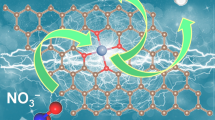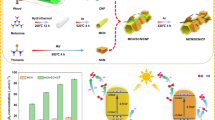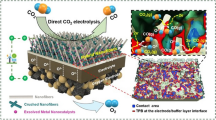Abstract
A series of nitrogen-doped carbon nanofibers (N-CNFs) have been successfully synthesized via electrospinning N,N-dimethylformamide/polyacrylonitrile followed by KOH activation heat treatment. The electrocatalysts are thoroughly studied with X-ray diffraction, field emission scanning electron microscope, transmission electron microscopy, nitrogen adsorption–desorption isotherms, X-ray photoelectron spectroscopy, respectively, and electrochemical method. The time of KOH activation heat treatment is found to yield a considerable effect on crystallinity, microstructure, chemical surface states, the total content of nitrogen and the active nitrogen configurations in all samples. The resulting N-CNFs-3.0 h catalyst shows remarkable advantages for ORR performance, including porous microstructures, high specific surface area, abundant exposed active sites and high content of ORR-active pyridinic-N. With these favorable features, N-CNFs-3.0 h exhibits an overall distinguished ORR performance in alkaline media compared to commercial 20 wt% Pt/C catalyst, which has a high onset potential of 0.9 V (vs. RHE), half-wave potential of 0.83 V (vs. RHE) and electron transfer number (3.93). The superior ORR of N-CNFs-3.0 h mainly originates from the synergistic effect of porous microstructures and high ORR-active pyridinic-N content, which could be optimized by changing KOH activation time. This work presents a facile strategy to controllably design and fabricate highly active ORR metal-free carbon-based electrocatalysts.







Similar content being viewed by others
References
Tian X, Zhou M, Tan C et al (2018) KOH activated N-doped novel carbon aerogel as efficient metal-free oxygen reduction catalyst for microbial fuel cells. Chem Eng J 348:775–785
Minh NQ (2004) Solid oxide fuel cell technology-features and applications. Solid State Ion 174(1–4):271–277
Morales-Acosta D, Arriaga LG, Vargas Gutiérrez G, Rodríguez Varela FJ (2011) Electrochemical investigation of Pt-Co/MWCNT as an alcohol tolerant. Int J Electrochem Sci 6:1835–1854
Sasikala N, Ramya K, Dhathathreyan KS (2014) Bifunctional electrocatalyst for oxygen/air electrodes. Energy Convers Manag 77:545–549
Audichon T, Mayousse E, Morisset S, Morais C, Comminges C, Napporn TW et al (2014) Electroactivity of RuO2–IrO2 mixed nanocatalysts toward the oxygen evolution reaction in a water electrolyzer supplied by a solar profile. Int J Hydrog Energy 39:16785–16796
Matter PH, Zhang L, Ozkan US (2006) The role of nanostructure in nitrogen-containing carbon catalysts for the oxygen reduction reaction. J Catal 239(1):83–96
Cheng Y, Tian Y, Fan X, Liu J, Yan C (2014) Boron doped multi-walled carbon nanotubes as catalysts for oxygen reduction reaction and oxygen evolution reaction in alkaline media. Electrochim Acta 143:291–296
Jin Y, Chen F (2015) Facile preparation of Ag–Cu bifunctional electrocatalysts for zinc-air batteries. Electrochim Acta 158:437–445
Choi CH, Lee SY, Park SH et al (2011) Highly active N-doped-CNTs grafted on Fe/C prepared by pyrolysis of dicyandiamide on Fe2O3/C for electrochemical oxygen reduction reaction. Appl Catal B 103(3–4):362–368
Geng D, Chen Y, Chen Y et al (2011) High oxygen-reduction activity and durability of nitrogen-doped graphene. Energy Environ Sci 4(3):760–764
Lai L, Potts JR, Zhan D et al (2012) Exploration of the active center structure of nitrogen-doped graphene-based catalysts for oxygen reduction reaction. Energy Environ Sci 5(7):7936–7942
Choi CH, Baldizzone C, Grote JP et al (2015) Stability of Fe–N–C catalysts in acidic medium studied by operando spectroscopy. Angew Chem Int Ed 54(43):12753–12757
Lee JH, Park MJ, Yoo SJ et al (2015) A highly active and durable Co–N–C electrocatalyst synthesized using exfoliated graphitic carbon nitride nanosheets. Nanoscale 7(23):10334–10339
Zhuang Z, Giles SA, Zheng J et al (2016) Nickel supported on nitrogen-doped carbon nanotubes as hydrogen oxidation reaction catalyst in alkaline electrolyte. Nat Commun 7:10141
Deng J, Li M, Wang Y (2016) Biomass-derived carbon: synthesis and applications in energy storage and conversion. Green Chem 18(18):4824–4854
Gong K, Du F, Xia Z et al (2009) Nitrogen-doped carbon nanotubes arrays with high electrocatalytic activity for oxygen reduction. Science 323(5915):760–764
Zhang B, Wen Z, Ci S et al (2014) Synthesizing nitrogen-doped activated carbon and probing its active sites for oxygen reduction reaction in microbial fuel cells. ACS Appl Mater Interfaces 6(10):7464–7470
Feng L, Yan Y, Chen Y et al (2011) Nitrogen-doped carbon nanotubes as efficient and durable metal-free cathodic catalysts for oxygen reduction in microbial fuel cells. Energy Environ Sci 4(5):1892–1899
Wang Y, Li J, Wei ZD (2018) Recent progress of carbon-based materials in oxygen reduction reaction catalysis. ChemElectroChem 5:1–12
Zhang J, Sun YM, Zhu JW et al (2018) Defect and pyridinic nitrogen engineering of carbon-based metal-free nanomaterial toward oxygen reduction. Nano Energy 52:307–314
Tuaev X, Paraknowitsch JP, Illgen R et al (2012) Nitro-gen-doped coatings on carbon nanotubes and their stabilizing effect on Pt nanoparticles. Phys Chem Chem Phys 14:6444–6447
Yu D, Zhang Q, Dai L (2010) Highly efficient metal-free growth of nitrogen-doped single-walled carbon nanotubes on plasma etched substrates for oxygen reduction. J Am Chem Soc 132:15127–15129
Zhang L, Xia Z (2011) Mechanisms of oxygen reduction reaction on nitrogen-doped graphene for fuel cells. J Mater Chem 115:11170–11176
Luo Z, Lim S, Tian Z et al (2011) Pyridinic N doped graphene: synthesis, electronic structure and electrocatalytic property. J Mater Chem 21:8038
Zhang J, Lv M, Liu D et al (2018) Nitrogen-doped carbon nanoflower with superior ORR performance in both alkaline and acidic electrolyte and enhanced durability. Int J Hydrog Energy 49(9):4311–4320
Cao L, Lin Z, Huang J et al (2017) Nitrogen doped amorphous carbon as metal free electrocatalyst for oxygen reduction reaction. Int J Hydrog Energy 42(2):876–885
Yang L, Shui J, Du L et al (2019) Carbon-based metal-free ORR electrocatalysts for fuel cells: past, present, and future. Adv Mater 31(13):1804799
Zhang B, Kang F, Tarascon JM et al (2016) Recent advances in electrospun carbon nanofibers and their application in electrochemical energy storage. Prog Mater Sci 76:319–380
Wang HG, Yuan S, Ma DL et al (2015) Electrospun materials for lithium and sodium rechargeable batteries: from structure evolution to electrochemical performance. Energy Environ Sci 8(6):1660–1681
Zhang L, Aboagye A, Kelkar A et al (2014) A review: carbon nanofibers from electrospun polyacrylonitrile and their applications. J Mater Sci 49(2):463–480. https://doi.org/10.1007/s10853-013-7705-y
Liu XM, Dong Huang Z, Woon O et al (2012) Carbon nanotubes (CNT)-based composites as electrode material for rechargeable Li-ion batteries: a review. Compos Sci Technol 72(2):121–144
Zhang CL, Yu SH (2014) Nanoparticles meet electrospinning: recent advances and future prospects. Chem Soc Rev 43(13):4423–4448
Zhu Y, Murali S, Stoller MD et al (2011) Carbon-based supercapacitors produced by activation of graphene. Science 332(6037):1537–1541
Muthuswamy N, Buan MEM, Walmsley JC et al (2018) Evaluation of ORR active sites in nitrogen-doped carbon nanofibers by KOH post treatment. Catal Today 301:11–16
Huang B, Peng L, Yang F et al (2017) Improving ORR activity of carbon nanotubes by hydrothermal carbon deposition method. J Energy Chem 26:712–718
Thommes M, Kaneko K, Neimark AV et al (2015) Physisorption of gases, with special reference to the evaluation of surface area and pore size distribution (IUPAC Technical Report). Pure Appl Chem 87(9–10):1051–1069
Zhang W, Sun H, Zhu Z et al (2020) N-doped hard carbon nanotubes derived from conjugated microporous polymer for electrocatalytic oxygen reduction reaction. Renew Energy 146:2270–2280
Erable B, Duteanu N, Kumar SMS et al (2009) Nitric acid activation of graphite granules to increase the performance of the non-catalyzed oxygen reduction reaction (ORR) for MFC applications. Electrochem Commun 11(7):1547–1549
Nakao S (1994) Determination of pore size and pore size distribution: 3. Filtration membranes. J Membr Sci 96(1–2):131–165
Groen JC, Peffer LAA, Pérez-Ramírez J (2003) Pore size determination in modified micro-and mesoporous materials Pitfalls and limitations in gas adsorption data analysis. Microporous Mesoporous Mater 60(1–3):1–17
Yan D, Li Y, Huo J et al (2017) Defect chemistry of nonprecious-metal electrocatalysts for oxygen reactions. Adv Mater 29(48):1606459
Sadezky A, Muckenhuber H, Grothe H et al (2005) Raman microspectroscopy of soot and related carbonaceous materials: spectral analysis and structural information. Carbon 43:1731–1742
Zhao X, Zou X, Yan X et al (2016) Defect-driven oxygen reduction reaction (ORR) of carbon without any element doping. Inorg Chem Front 3(3):417–421
Gao L, Xiao M, Jin Z et al (2018) Hydrogen etching induced hierarchical meso/micro-pore structure with increased active density to boost ORR performance of Fe–N–C catalyst. J Energy Chem 35:17–23
Liu Q, Cao S, Fu Y et al (2018) Trimetallic FeCoNi–N/C nanofibers with high electrocatalytic activity for oxygen reduction reaction in sulfuric acid solution. J Electroanal Chem 813:52–57
Musico YLF, Kakati N, Labata MFM et al (2019) One-pot hydrothermal synthesis of heteroatom co-doped with fluorine on reduced graphene oxide for enhanced ORR activity and stability in alkaline media. Mater Chem Phys 236:121804
Ouyang C, Ni B, Sun Z et al (2019) Boosting the ORR performance of modified carbon black via C–O bonds. Chem Sci 10:2118–2123
Wu Y, Chen Y, Wang H et al (2018) Efficient ORR electrocatalytic activity of peanut shell-based graphitic carbon microstructures. J Mater Chem A 10:1039
Wong WY, Daud WRW, Mohamad AB et al (2014) The impact of loading and temperature on the oxygen reduction reaction at nitrogen-doped carbon nanotubes in alkaline medium. Electrochim Acta 129:47–54
Vazquez-Arenas J, Higgins D, Zhu C et al (2012) Mechanistic analysis of highly active nitrogen-doped carbon nanotubes for the oxygen reduction reaction. J Power Sources 205(5):215–221
Strickland K, Miner E, Jia Q et al (2015) Highly active oxygen reduction non-platinum group metal electrocatalyst without direct metal–nitrogen coordination. Nat Commun 6:7343
Zitolo A, Goellner V, Armel V et al (2015) Identification of catalytic sites for oxygen reduction in iron-and nitrogen-doped graphene materials. Nat Mater 14(9):937
Mamtani K, Ozkan US (2015) Heteroatom-doped carbon nanostructures as oxygen reduction reaction catalysts in acidic media: an overview. Catal Lett 145(1):436–450
Yang X, Zou W, Su Y et al (2014) Activated nitrogen-doped carbon nanofibers with hierarchical pore as efficient oxygen reduction reaction catalyst for microbial fuel cells. J Power Sources 266:36–42
Jia Y, Zhang L, Du A et al (2016) Defect graphene as a trifunctional catalyst for electrochemical reactions. Adv Mater 28:9532–9538
Liu Y, Huang B, Zhang X et al (2019) In-situ fabrication of nitrogen-doped carbon nanosheets containing highly dispersed single iron atoms for oxygen reduction reaction. J Power Sources 412:125–133
Zhu Z, Chen C, Cai M et al (2019) Porous Co–N–C ORR catalysts of high performance synthesized with ZIF-67 templates. Mater Res Bull 114:161–169
Alonso-Lemus IL, Escobar-Morales B, Lardizabal-Gutierrez D et al (2019) Onion skin waste-derived biocarbon as alternative non-noble metal electrocatalyst towards ORR in alkaline media. Int J Hydrog Energy 44(24):12409–12414
Subramanian NP, Li X, Nallathambi V et al (2009) Nitrogen-modified carbon-based catalysts for oxygen reduction reaction in polymer electrolyte membrane fuel cells. J Power Sources 188(1):38–44
Matter PH, Ozkan US (2006) Non-metal catalysts for dioxygen reduction in an acidic electrolyte. Catal Lett 109(3–4):115–123
Li Y, Zou B, Hu C et al (2016) Nitrogen-doped porous carbon nanofiber webs for efficient CO2 capture and conversion. Carbon 99:79–89
Chetty R, Kundu S, Xia W et al (2009) PtRu nanoparticles supported on nitrogen-doped multiwalled carbon nanotubes as catalyst for methanol electrooxidation. Electrochim Acta 54(17):4208–4215
Guo D, Riku S, Chisato A et al (2016) Active sites of nitrogen-doped carbon materials for oxygen reduction reaction clarified using model catalysts. Science 351:361–365
Du Z, Wang S, Kong C et al (2015) Microwave plasma synthesized nitrogen-doped carbon nanotubes for oxygen reduction. J Solid State Electrochem 19(5):1541–1549
Acknowledgements
This study was funded by National Natural Science Foundation of China (Grants No.: 51272187 and Grants No.: 11704288), the Science and Technology Supporting Program of Hubei province (Grants No.: 2015BAA093, 2013CFA012), the Scientific Project provided by Wuhan Government (Grants No.: 2016010101010026) and the Youth Innovation Talents Program of Guangzhou Maritime University (2014E073, G410304).
Author information
Authors and Affiliations
Corresponding author
Ethics declarations
Conflict of interest
The authors declare that they have no conflict of interest.
Additional information
Publisher's Note
Springer Nature remains neutral with regard to jurisdictional claims in published maps and institutional affiliations.
Rights and permissions
About this article
Cite this article
Shenggao, W., Wen, H., Mingchen, Z. et al. Synergistic effects of microstructures and active nitrogen content on the oxygen reduction reaction performance of nitrogen-doped carbon nanofibers via KOH activation heat treatment. J Mater Sci 55, 10725–10739 (2020). https://doi.org/10.1007/s10853-020-04673-9
Received:
Accepted:
Published:
Issue Date:
DOI: https://doi.org/10.1007/s10853-020-04673-9




